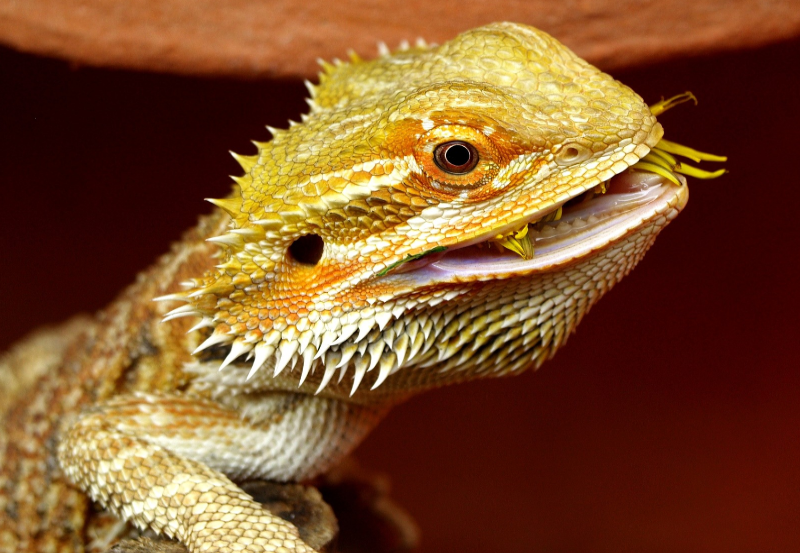There are primarily three ways you can feed live insects to your bearded dragon. Ultimately, you can choose the method that works best for you and your particular reptile.
Top 3 Ways to Feed Live Insects
One by One
Although it may seem inconvenient, a great way to feed live insects to your beardie is by placing them one by one into the tank using tweezers or a little pair of tongs. This method is especially helpful when feeding baby beardies, who may not be fast enough to chase and attack multiple live prey before they run off and hide in the tank’s fixtures or bury themselves in substrate. Not to mention a baby may get overeager when presented with many insects at once, which can lead to overeating. This is problematic because babies can easily become obese.
Pro Tip: Don’t feed the live insects by hand. Otherwise your eager, hungry dragon may take a bite out of you by mistake!
Free for All
Dropping all the bugs in the tank is a good option for adult dragons or older juvies. It is most effective in terrariums that are lined with a special reptile carpet or another alternative to substrate, since live prey (especially worms) may bury themselves before they are caught, thus putting your dragon at risk of eating the dangerous stuff along with the good stuff. If you do choose this method, all you have to do is collect the number of insects you’d like to feed using either a plastic cup or the egg carton pieces in your breeding home, give them a quick dusting with calcium powder, and shake them off into the cage.
Feeding Dish
Another option is to place a few insects at a time into a feeding dish filled with veggies, creating a protein-infused salad for your pet. Bearded dragons are generally known for their voracious appetite and quick eating, so this is a great way to regulate their intake without placing the insects in one by one. This technique is especially effective with juvie dragons who are still getting the hang of hunting.

Live Insect Feeder Tips
Regardless of the feeding method you choose, here are some tips you’ll want to keep in mind to give your beardie the best mealtime experience:
- Feeding Schedule. At any age your dragon will thrive on a regular feeding schedule. Every dragon has different health needs, so you and your vet can determine what works best for your beardie.
- Dusting Live Insects. Before feeding your dragon live insects, dust them with a light coat of calcium powder or vitamin D3. As a general rule of thumb, you can dust insects on a daily basis, but we always advise talking to your vet about how often you should be dusting, as it differs for each individual dragon based on factors like age, size, health, eating habits, etc.
- Ten to Fifteen Minute Rule. In general a live insect feeding should last no longer than ten to fifteen minutes. (Of course, verify this with your pet’s vet.) Most dragons tend to gobble up what’s in front of them, so if you feed past ten to fifteen minutes you could increase their chance of obesity. If your dragon stops showing interest or signs of hunger before the timed interval is up, it’s okay to stop feeding them at that point.
- Baby Dragons. Baby dragons (birth to four months old) typically need live insect feedings three to four times daily. Usually the tweezers or food dish technique are best for babies so you don’t overwhelm them. It’s vital to regulate the size of the insects you are feeding your baby dragon. If the bugs are too big, your baby could die trying to eat them. A good rule of thumb for any dragon is to make sure the size of the bug is no bigger than the space between your dragon’s eyes.
- Juvie Dragons. Juvenile bearded dragons (five to eighteen months) can be fed live insects up to three times a day. You know your pet best and can determine if she is hungry for bugs once, twice, or three times in a given day. One particular concern with juvies occurs when they are fed crickets. If you put too many crickets in the cage at once, the juvie dragon becomes easily overwhelmed as the hopping bugs scatter all over the terrarium, possibly hiding or jumping on your dragon. If you are feeding crickets and don’t want to use the tweezer method, you can place a sealed bag of crickets in the fridge for five minutes prior to feeding, which significantly slows them down.
- Adult Dragons. Adult bearded dragons typically need a live insect feeding once a day or once every other day. It’s up to you and your beardie’s vet to determine the best feeding schedule for your reptile friend.
- Obesity Risk. Be careful not to overfeed your dragon. Since your beardie is domesticated and not out roaming the wild in his natural habitat, he is always at risk of obesity. But you can prevent that with proper feedings, a nutritive diet, and healthy portion sizes.
Potential Feeder Problems
Any time you feed live insects to your dragon, it’s important to remember these common issues and how to avoid them.
|
Issue |
Solution |
|
Insects crawl away. |
Use the feeding dish or tweezer method until your dragon can hunt more quickly. |
|
Prey hides in various fixtures throughout the terrarium. (Possibly they hide so long that they die before being eaten.) |
Be observant during feeding times. Remove any insects that your dragon is not eating. Possibly change your feeding approach until your beardie is more comfortable with many prey at once. |
|
Insects (especially worms) bury themselves in substrate. |
Avoid using substrate altogether, or use the tweezer method or food dish method. |
|
Roaming prey crawls on your dragon. |
Use the tweezer method. |
One final note: remember to have fun! Whichever live insect feeding method you choose, take the opportunity to bond with your scaly friend. Mealtime is more exciting for them when you can enjoy it too.
Have any questions or concerns? We are here to help! Please email us at Team@Dragonsdiet.com.








